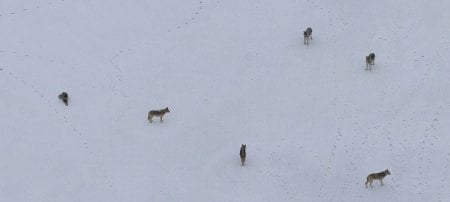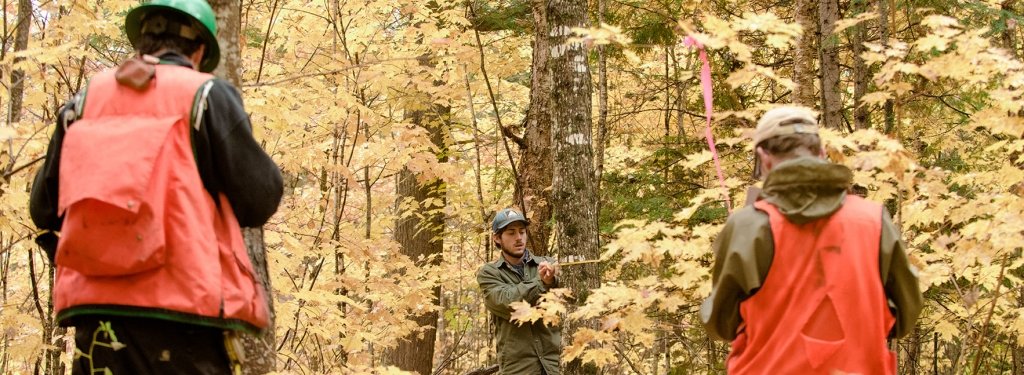Bear Baiting May Put Hunting Dogs at Risk from Wolves

Bear hunters will tell you that a good way to attract a bear is to put out bait. And in 10 states, including Michigan and Wisconsin, that’s perfectly legal. Hunting dogs are another useful technique in the bear-hunter’s toolkit, and 17 states say that’s just fine.
But who else likes bear bait? Gray wolves, that’s who. And wolves that are feeling territorial about a bear bait stash can—and sometimes do—kill hunting dogs released at the bait site.
Like most interactions between wildlife and human beings, wolf attacks on hunting dogs illustrate a tangled trade-off: attracting bears for the hunters, attracting danger for their dogs.
Seeking possible ways to reduce potentially lethal encounters between wolves and bear hunting dogs, researchers at Michigan Technological University and the Michigan Department of Natural Resources compared bear hunting practices and regulations in Michigan and Wisconsin.
Joseph K. Bump, a Michigan Tech wildlife ecologist; Dean Beyer Jr. and Brian J. Roell from the Michigan DNR, and students Chelsea Murawski and Linda Kartano report their findings in the April 17, 2013 issue of the Public Library of Science (PLOS) journal PLOS ONE.
The researchers analyzed and compared a variety of factors in Michigan and Wisconsin, from regulations on bear baiting and compensation for hunting dog attacks to statistics such as the ratio of hunters to wolves and percentage of hunters using dogs to hunt bear.
They found that the neighboring states, with similar wolf and bear populations and similar numbers of bear-hunting permits issued per wolf, report dramatically different numbers of wolf attacks on hunting dogs. Wisconsin’s relative risk of attack is two to seven times higher than Michigan’s.
Bear baiting begins earlier in Wisconsin and lasts longer, the scientists note. “The longer you bait, the more opportunity you provide for wolves to discover and potentially defend bear-bait sites,” says Bump. “Most hunters release their dogs at bait sites, and the longer the bait has been around, the more likely hunting dogs are to encounter territorial wolves who have found and are possibly defending the bait. So it appears that baiting is an important factor.”
Wisconsin also compensates dog owners $2,500 per hunting dog killed by wolves. In fact, the Wisconsin DNR data show that compensation for wolf attacks on hounds costs the state more than it has spent for wolf attacks on any other category of domesticated animal, including calves, missing calves or cattle.
Michigan does not compensate dog owners for wolf attacks.
“Compensation can have multiple effects,” Bump points out. “ It is a reporting incentive, but it also creates an incentive for abuse. The net effect of compensation is far from clear, and it is an important factor to study further.”
What can be done about wolves that prey on hunting dogs? One quick and obvious response appears to be to reduce the wolf population. In fact, the Wisconsin DNR has announced its intention to reduce the statewide population of wolves by half, from approximately 700 to approximately 350.
Bump and his co-authors recommend more conservation-friendly alternatives such as adjusting baiting regulations to start baiting later and allow it for a shorter time. “If a reduction in depredations is the goal, actions aside from (or in addition to) reducing wolf abundance might achieve that goal,” they wrote in the PLOS ONE article.
“If stakeholders are serious about minimizing wolf depredations on bear-hunting dogs, then careful examination of the potentially exacerbating effects of bear baiting would appear to be a good idea,” the wildlife ecologist suggests.
This research was supported by a National Science Foundation (NSF) Summer Undergraduate Research Fellowship (SURF), an Actions for Transatlantic Links and Academic Networks for Training and Integrated Studies (ATLANTIS) fellowship and the Ecosystem Science Center at Michigan Tech.
Michigan Technological University is an R1 public research university founded in 1885 in Houghton, and is home to nearly 7,500 students from more than 60 countries around the world. Consistently ranked among the best universities in the country for return on investment, Michigan's flagship technological university offers more than 120 undergraduate and graduate degree programs in science and technology, engineering, computing, forestry, business, health professions, humanities, mathematics, social sciences, and the arts. The rural campus is situated just miles from Lake Superior in Michigan's Upper Peninsula, offering year-round opportunities for outdoor adventure.




Comments